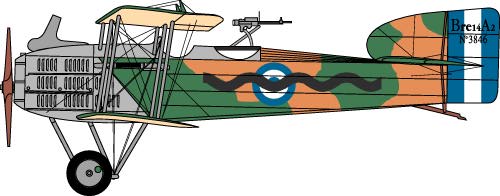
Greek Air Force Breguet Br. 14 A2 circa 1921
Greece finally entered World War I, in its very last phase, on the side of the Entente. Greece’s territorial gains this time proved to be short-term. After the Treaty of Sèvres (1920) Greece took over the administration of the Smyrna region in Asia Minor, a former Ottoman land. Despite Venizelos’s diplomatic triumph in the elections of 1920 he was defeated by the royalists, who took advantage of the war weariness of the population, and Constantine returned to the country. Greece sent troops to Asia Minor to defend its territorial gains against the rising tide of Turkish nationalism led by Mustafa Kemal. The Greek military campaign against the Turkish troops failed, and the Turkish counteroffensive resulted in the defeat of the Greek army and the expulsion of the entire Greek populations from Asia Minor in 1922.
After WORLD WAR I, the Allied Powers supported Greek occupation of Smyrna, which had been part of the German- allied Ottoman Empire. In the meantime, Mustafa Kemal (1881–1938) (later renowned as Kemal Atatûrk) successfully led a revolution against the government of Sultan Muhammad VI (r. 1918–22) and set up a new provisional republican Turkish government at Ankara in 1920. For their part, the Greeks wanted to expand what the post–World War I Treaty of Sèvres had given them, Smyrna, to include Thrace and as much of Anatolia as they could manage to acquire. On June 22, 1920, the Greek army under Alexander I (1893–1920) began its advance inland, taking Alasehir on June 24. The advance paused here while Greeks and Turks negotiated at Constantinople (later Istanbul). Muhammad VI had agreed to certain concessions, which Kemal now refused to honor. The negotiations broke down, and the Greek offensive resumed on March 23, 1921.
At Inönü 150 miles west of Ankara, a Turkish force under Ismet Pasha (1884–1973) retarded the advance of 37,000 Greek troops. By August 24, 1921, however the Greeks had reached the Sakarya River, 70 miles outside Ankara, where they would fight the decisive battle of the war. The battle commenced on August 24, 1921, and pitted 50,000 Greeks against 44,000 Turks, who were subsequently reinforced by an additional 8,000. Although the Greeks initially succeeded in driving back the Turkish center, on September 10, Kemal led a small reserve force in an attack on the Greek left flank. Fearing envelopment, the Greeks disengaged and withdrew to Smyrna, having lost 3,897 killed and 19,000 wounded. An additional 15,000 had been captured or were missing in action. Turkish losses were 3,700 killed, 18,000 wounded, and 1,000 missing or taken prisoner.
Following their victory at the Sakarya, the Turks intensified their counteroffensive, beginning on August 18, 1922, laying siege to Smyrna. It fell to the Turks on September 9, and the Greek forces were expelled from the island.
The flight of about 1.3 million Greeks from Turkey was later ratified by the Treaty of Lausanne (1923), which also provided for the transfer of 380,000 Muslims to Turkey in the framework of the forced exchange of populations between Greece and Turkey. The defeat in Asia Minor caused a major political crisis. A Revolutionary Committee of officers forced Constantine to leave the country for a second time and a Commission of Inquiry put the blame for the Asia Minor debacle on leading royalist ministers and officers: six of them were sentenced to death and executed. Constantine abdicated and retired to Sicily, where he died soon after. After a plebiscite in April 1924 the monarchy was abolished and Greece was proclaimed a republic.
Further reading: Marjorie Housepian Dobkin, Smyrna 1922: The Destruction of a City (New York: New Mark Press, 1999).